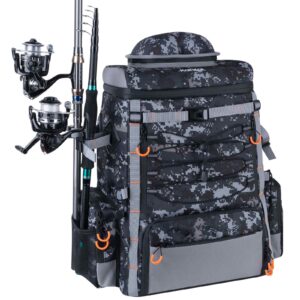Hunters and individuals involved in bear hunting need to learn all they can about bear behavior. One of the most important things is to understand what attracts these animals and choose the best bait for your hunting.
In this guide, we discuss the feeding behavior of bears and give you insights into choosing the right bait and making the best bear bait barrel. We will also provide key information about baiting techniques and consider some ethical issues associated with it.
Understanding Bear Feeding Habits
So, bears are omnivores, which means they feed on plants and animals and almost all the other food sources that exist in the world. They feed on a large variety of foods so that they can inhabit diverse environments and endure situations where the optimum foods are hard to come by.
For instance, in the spring, bears that wake from hibernation will usually concentrate on consuming green grasses and shoots to gain back their strength. Later in the summer, they may turn to fruits such as berries which provide carbohydrates and fats needed for fat deposition for the winter.
During autumn, nuts and seeds are consumed in large proportions because they are a good source of energy required during hibernation. They may also feed on insects, fish, and even carrion throughout the year depending on the availability of these resources.
What Do Bears Eat?
- Plant matter: Fish is the largest single component in bear diets, often constituting its staple food. Some of the things they feed on are berries, fruits, nuts, roots, grass, and even bark.
- Animal matter: Although not all species of bears are hunters, most of them eat spiders, fish, rats, birds, and even big game like minks, raccoons, deer, or elks. They also feed on dead animals or carcasses.
- Honey: Honey is one food that bears are particularly fond of and they will do anything to get it.
Factors Influence a Bear’s Diet
- Species: Some species of bears like the Polar bears feed mainly on ‘meat,’ while others like the Giant pandas feed mostly on plant matter.
- Habitat: Forest-dwelling bears will have to be fed differently from coastal or mountain-dwelling bears.
- Season: Bears’ food is available seasonally; therefore, their diet changes throughout the year. For example, bears living in a colder environment sleep during the winter and subsist on fat that has been stored.
- Food availability: In other words, if a certain food species is preferred, bears will be forced to switch to other available foods.
- Individual preferences: Like human beings, bears also have their unique preferences when it comes to certain types of food.
What Are The Best Baits For Bears?
Since Bears are omnivores with a keen sense of smell, they are attracted to a variety of foods. While there’s no guaranteed “best” bait, certain ingredients have proven effective in luring these curious creatures.
Popular Bear Bait Ingredients
Sweet Treats
- Donuts
- Pastries
- Cookies
- Candy
- Honey
- Jellies
- Fruit (like berries, apples, or peaches)
Savory Options
- Fish (especially oily varieties)
- Meat scraps
- Chicken or beef fat
- Oats
- Popcorn
- Bread
Commercial Bear Baits
There are many commercial baits available for attracting bears, which are usually pre-mixed bear baits that are highly tempting. There is normally a sweet element, including sugar, honey, or molasses, a savory component, frequently meat, fats, and oils in these baits.
These may also include things like; nuts-grains-artificial flavors to replicate some of the natural food sources that attract bears. Buying commercial bear bait is easy for you, and it also takes a shorter time than preparing the bait yourself.
It is however important to consider the legally acceptable baits in your locality and also how the manufacturer advises you to use the bait.
How to Create a Bait Recipe?
While you can experiment with different combinations, here are a few basic recipes to get you started:
- Sweet and Salty Mix: Combine donuts, cookies, oats, and a bit of fish or meat scraps for a balanced offering.
- Fruity Delight: Mix berries, apples, and honey for a natural-tasting bait.
- Oily Temptation: Combine oats, fish oil, and a few drops of anise extract for a strong scent.
While making your own bear bait recipe, there are some points to remember:
- Variety is key: Rotate baits to keep bears interested.
- Scent is crucial: Strong-smelling baits are more effective.
- Placement is important: Place bait in an area that provides good visibility for hunting.
- Legal considerations: Adhere to all local hunting and baiting regulations.
Some hunters swear by adding pungent scents like anise, vanilla, or even rotten eggs to their baits. Take into account the time of year and local food availability when choosing your bait, and don’t be afraid to experiment with different bait combinations to find what works best in your area.
Caution: Always prioritize safety when baiting bears. Avoid approaching bears, and be aware of your surroundings.
How To Make a Bear Baiting Barrel?
A bear baiting barrel is a container used to hold bait for bears. The purpose is to slowly release bait, enticing bears to return to the area for extended periods, thus increasing the chances of a successful hunt.
Materials Needed
- A sturdy metal barrel (55-gallon is common)
- A metal saw or grinder
- Welding equipment (optional, for extra reinforcement)
- A drill with a metal bit
- Cable or chain for securing the barrel
Best Hole Size
The hole size is crucial. It should be small enough to prevent the bear from accessing the entire bait at once, forcing it to return for more. A good starting point is a hole about the size of a quarter.
Step to Make a Bear Baiting Barrel
- Clean the barrel: Ensure the barrel is thoroughly cleaned to remove any odors that might deter bears.
- Create the hole: Using a metal saw or grinder cut a small hole in the top of the barrel. This is where the bait will trickle out.
- Reinforcement (optional): For added durability, you can weld a metal plate around the hole to prevent it from enlarging.
- Secure the barrel: Use cable or chain to securely anchor the barrel to a tree or other sturdy object to prevent bears from dragging it away.
Bear Barrel Tips:
- Consider using a barrel with a tight-fitting lid to prevent rain from diluting the bait.
- Experiment with different hole sizes to find what works best in your area.
- Regularly replenish the bait to maintain the bear’s interest.

Bear Baiting Tips: How to Bait Bear?
The use of bait is more of a strategy than just trying to lure bears. To successfully lure these magnificent creatures to your tree stand, consider these essential tips
Choosing the Perfect Bait Site
- Isolation: Choose an area that humans do not frequent and other bait stations you may have set. Bears are anxious animals and they do not like companies while they are feeding.
- Wind Direction: Place your bait site downwind from your stand with the wind blowing directly at your bait site. This makes it possible for the bear to smell the bait in the best way possible.
- Terrain: Choose an area that is visible and where the shooter has a clear line of sight. A very small raise can open up a view.
- Legal Compliance: Make sure that the site complies with all the legal requirements on hunting and baiting.
Crafting an Irresistible Bait
- Variety is Key: Switch between different baits to ensure bears do not lose interest in feeders. Having sweet, salty, and oily meals is extremely up to par with each other’s effectiveness.
- Scent Enhancement: Place additional stinky substances like anise, vanilla, or rotten eggs to enhance the bait’s effectiveness.
- Freshness Matters: The bait should be changed frequently so that it remains appealing to the target animals. Fresh bait attracts bears while stale bait will not entice the bear.
- Consider the Season: This means that you have to change the bait depending on the season that you are in. For instance, berries may be more attractive in the summer.
Timing and Frequency
- Consistency: Habitual baiting creates a routine diet supply, thus ensuring frequent visits by the target species.
- Peak Activity: Concentrate on baiting during the hours when bears are most active, mainly at dawn and in the evening.
- Monitor Camera: Put up trail cameras to monitor the bears’ activity and change the bait staking pattern.
- Patience: If one is to develop a consistent bear pattern, it would require some time. Do not over-bait the web link, as people tend to lose interest in clicking it frequently.
Additional Tips
- Cleanliness: Ensure the bait site is clean to avoid diseases that may prevent the bears from coming to the site.
- Safety First: It is always important to consider safety when dealing with bears and what they feed on.
- Legal and Ethical Hunting: Comply with all regulations and other ethical aspects of hunting.
Ethical Concerns About Bear Baiting
Concerns about bear baiting
Bear baiting is an activity that has huge ethical concerns associated with it. Critics argue that it:
- Unfairly manipulates the bear: When hunters apply artificial attractants, they put the bear in what could be termed a predictable and helpless position all in the name of hunting thus negating the principle of fair chase.
- Increases human-bear conflict: Site attraction bears can get concentrated around bait sites hence upping the risks that they might cause property damage or even injure a human being.
- Impacts bear behavior: The availability of easy food kills natural behavior and also makes bears depend more on human beings instead of going out to look for natural food.
- Potential for animal suffering: Bears may fight other bears for bait resulting in deaths or different injuries.
How bear baiting is regulated?
Due to these concerns, many jurisdictions have implemented strict regulations on bear baiting, including:
- Permit requirements: Bear baiting requires hunters to acquire permits, which may require certain levels of training or safety classes.
- Bait site restrictions: There may be restrictions concerning the placement, dimensions, and specific content of bait.
- Hunting season limitations: It is also important to note that bear baiting may be banned for certain periods to avoid overstressing the bear population.
- Monitoring and enforcement: Wildlife agencies typically pay attention to bait sites and set laws to be followed and implemented.
Bear Hunters’ Responsibility
Hunters who engage in bear baiting have a responsibility to follow the rules:
- Adhere to all regulations: People should respect local laws to prevent harming the bears and to avoid getting in danger.
- Practice safety: Firearms and bear precautions are crucial here.
- Minimize impact: Hunters should ensure that they do not interfere much with the ecosystem and other animals in the environment.
- Ethical hunting: Ethical hunting is therefore characterized by respecting the animal as well as making sure that the animal dies instantly.
Conclusion
Knowledge about bear habits and food preferences is essential for conservation, population control, and hunting. However, baiting is a good tactic nonetheless; safety, legalities, and ethicality should come first.
Thus, the choice of bait, the construction of an appropriate barrel, and adherence to safe practices allow hunters and wildlife enthusiasts to maximize their interactions with bears while reducing potential harm to bears.
It is imperative to always respect local laws and ensure that these magnificent creatures are conserved.




















Leave a reply